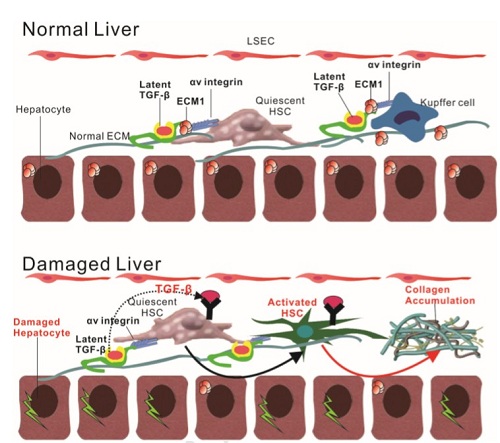ECM1 in regulation of liver fibrosis
Source:
Time: 2019-08-08
A team of researchers at Shanghai Institute of Biochemistry and Cell Biology (SIBCB), Chinese Academy of Sciences, co-worked with teams from Capital Medical University, Southern Medical University and Heidelberg University reported July 27th online in Gastroenterology “ECM1 Prevents Activation of Transforming Growth Factor beta, Hepatic Stellate Cells, and Fibrogenesis in Mice” which identified ECM1 as an important regulator of liver fibrosis.
Hepatic fibrosis is a chronic wound-healing response to liver damage of any etiology, results from an imbalance in the dynamic extracellular matrix remodeling process, which leads to excessive accumulation of structural proteins in the injured liver regions, especially collagen type I. Cirrhosis is an advanced liver fibrosis stage accompanied by distortion of hepatic structure and function. However, no approved treatments specifically target the mechanisms underlying fibrosis due to the potential risk of multiple side effects of successful experimental approaches in humans, such as interference with normal wound healing and homeostasis in other organs.
Researchers found that ECM1-KO mice spontaneously developed liver fibrosis and died by 2 months of age without significant hepatocyte damage or inflammation. In liver tissues of mice, ECM1 stabilized extracellular matrix-deposited TGFB in its inactive form by interacting with αv integrins to prevent activation of HSCs. In liver tissues from patients and in mice with CCl4-induced liver fibrosis, an inverse correlation exist between level of ECM1 and severity of fibrosis. CCl4-induced liver fibrosis was accelerated in ECM1Δhep mice compared with control mice. Hepatocytes produced the highest levels of ECM1 in livers of mice. Ectopic expression of ECM1 or soluble TGFBR2 in liver prevented fibrogenesis in ECM1-KO mice and prolonged their survival. Ectopic expression of ECM1 in liver also reduced the severity of CCl4-induced fibrosis in mice.
Activation of transforming growth factor beta (TGFB) promotes liver fibrosis by activating hepatic stellate cells (HSCs), but the mechanism of TGFB activation are not clear. Here, researchers investigated the role of extracellular matrix protein 1 (ECM1), produced by hepatocytes, inhibits activation of TGFB and its activation of HSCs to prevent fibrogenesis in mouse liver. Mechanical studies show that ECM1 kept TGFB in its inactive form by interacting with αv integrins to prevent HSC activation and liver fibrosis. Thus strategies to increase levels of ECM1 in liver might be developed for treatment of fibrosis.
This work was supported by the Ministry of Science and Technology of China; the Strategic Priority Research Program of the Chinese Academy of Sciences, and the National Natural Science Foundation of China from Bing’s Lab, and the grant from the Ministry of Science and Technology of China.
Email: Bing Sun, bsun@sibs.ac.cn


 Appendix:
Appendix: